¿Quieres añadir un índice de contenidos a tus entradas o páginas de WordPress?
Un índice de contenidos (TOC) puede facilitar la navegación por un artículo largo y mejorar el SEO de su sitio WordPress. Sin embargo, su creación puede resultar complicada para los principiantes.
En este artículo, le mostraremos cómo crear una tabla de contenidos en entradas y páginas de WordPress.
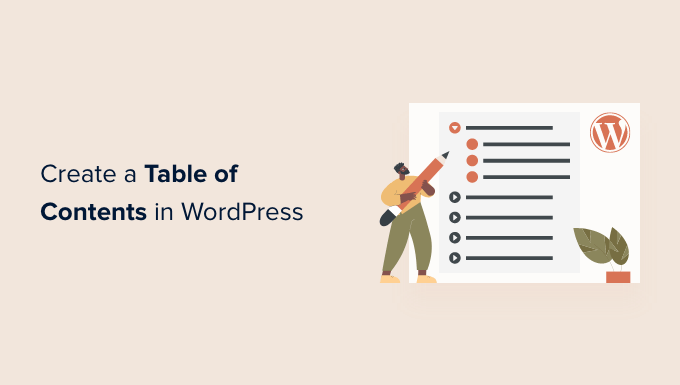
¿Por qué añadir una tabla de contenidos a entradas y páginas en WordPress?
Es posible que hayas visto la tabla de contenidos en sitios web como Wikipedia. También los utilizamos en WPBeginner para nuestros artículos largos, como nuestra guía definitiva para aumentar la velocidad y el rendimiento de WordPress.
Puede añadir una tabla de contenidos a las entradas de su sitio web en WordPress para facilitar el salto entre las secciones de un artículo largo.
No solo mejoran la experiencia del usuario, sino que también ayudan al SEO de WordPress. Esto se debe a que Google puede utilizar la tabla de contenidos para añadir automáticamente enlaces de “saltar a la sección” en los resultados de búsqueda.

Un índice de contenidos también puede ayudar a que su entrada aparezca como fragmento de código destacado en la parte superior de la página de resultados del motor de búsqueda.
Esto le ayudará a conseguir el máximo tráfico SEO.
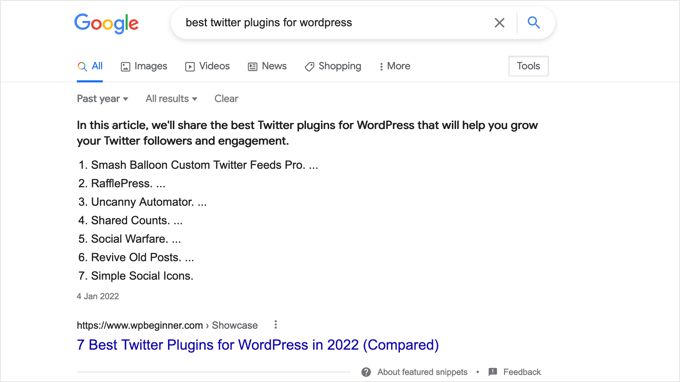
Dicho esto, vamos a ver cómo crear fácilmente un índice de contenidos en entradas y páginas de WordPress. Te mostraremos cómo hacerlo automáticamente con un plugin y manualmente usando enlaces de anclaje:
Método 1: Añadir una tabla de contenidos automáticamente en WordPress
AIOSEO, también conocido como All in One SEO, es el mejor plugin SEO para WordPress, y viene con un bloque de tabla de contenidos integrado para WordPress.
Recomendamos este método porque le ahorra tiempo al generar automáticamente el índice de contenidos basándose en sus subtítulos, al tiempo que lo hace completamente personalizable con enlaces editables.
Para más información, consulte nuestra reseña / valoración completa de AIOSEO.
Lo primero que debe hacer es instalar el plugin gratuito All in One SEO Lite. Para más detalles, consulta nuestra guía paso a paso sobre cómo instalar un plugin de WordPress.
Sólo necesita la versión gratuita para añadir fácilmente un índice de contenidos, pero AIOSEO Pro ofrece aún más características que le ayudarán a posicionarse mejor en las páginas de resultados de los motores de búsqueda.
Una vez activado, deberá configurar el plugin mediante el asistente de configuración de AIOSEO. Para obtener instrucciones detalladas, consulte nuestra guía sobre cómo establecer All in One SEO para WordPress correctamente.
Añadir una tabla de contenidos con All in One SEO
Tendrás que crear o editar la entrada o página en la que deseas añadir el índice de contenidos. A continuación, haz clic en el icono azul “+” del editor de bloques y busca el bloque “AIOSEO – Tabla de contenidos”.
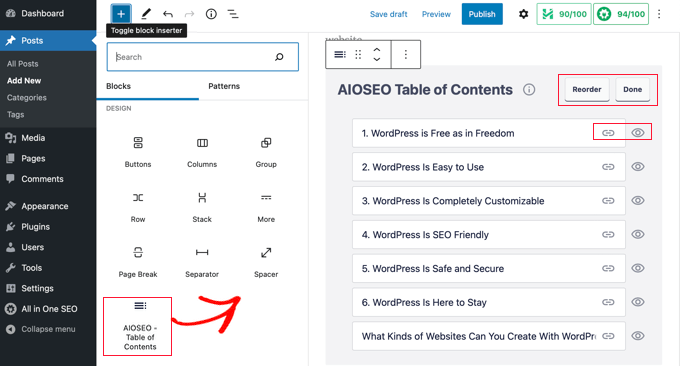
Simplemente arrastre el bloque a la entrada o página en la que desea que aparezca el índice de contenidos.
Nota: Una vez que añada un índice de contenidos, puede que note que el bloque “AIOSEO – Índice de contenidos” aparece en gris. Esto se debe a que solo puedes tener un índice por entrada o página.
El plugin identificará automáticamente los encabezados de la página y los añadirá a su tabla de contenidos. Si utiliza diferentes niveles de encabezados (por ejemplo, H2 y H3), los encabezados de nivel inferior se sangrarán para mostrar la estructura de su contenido.
Si todavía está escribiendo el contenido de su entrada o página, los encabezados que añada al documento se añadirán automáticamente al índice.
Personalización del índice de contenidos con SEO All in One
Hay varias formas de personalizar el índice para adaptarlo a sus necesidades. Por ejemplo, puede hacer clic en un encabezado para cambiarle el nombre. Esto renombrará el encabezado en la tabla de contenidos pero no el artículo.

AIOSEO creará automáticamente enlaces de anclaje para cada encabezado. Puede hacer clic en el icono Enlazar para editar el texto de anclaje, y éste se modifica tanto en el índice como en el encabezado en el contenido de la entrada.
También puede hacer clic en el icono del ojo situado al lado de cualquiera de los encabezados para ocultarlo. Los usuarios de AIOSEO Pro pueden reordenar los encabezados en el bloque del índice de contenidos. Al hacerlo, se reordenarán los encabezados en el índice de contenidos, pero no en el artículo.
También encontrará un ajuste para el bloque de la barra lateral. Aquí puede elegir un estilo de lista numerada o con viñetas para el índice de contenidos.
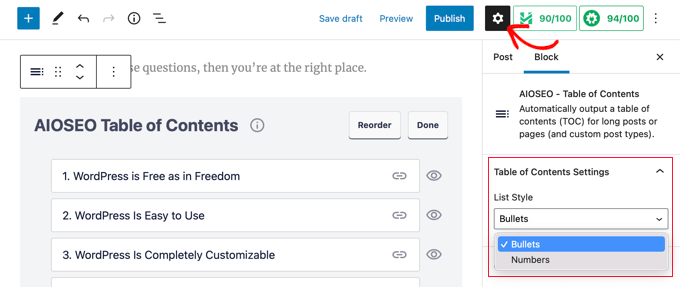
Por último, cuando haya terminado de personalizar su tabla de contenidos de WordPress, deberá hacer clic en el botón “Hecho” para guardar los cambios.
Ahora podrá ver qué aspecto tendrá el índice para sus visitantes.
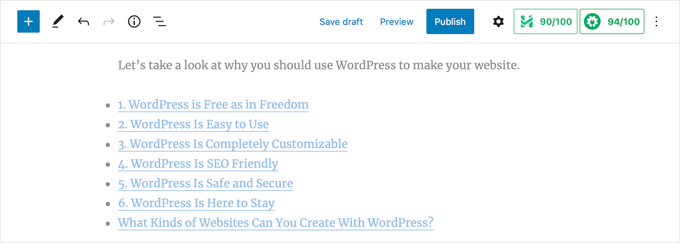
Es una buena idea añadir un encabezado o un párrafo encima del índice. De este modo, los lectores tendrán claro que se trata de un índice.
Cuando sus visitantes hagan clic en un enlace del índice de contenidos, irán inmediatamente a ese encabezado del artículo. Esto permite a los usuarios saltar a la sección que más les interesa.
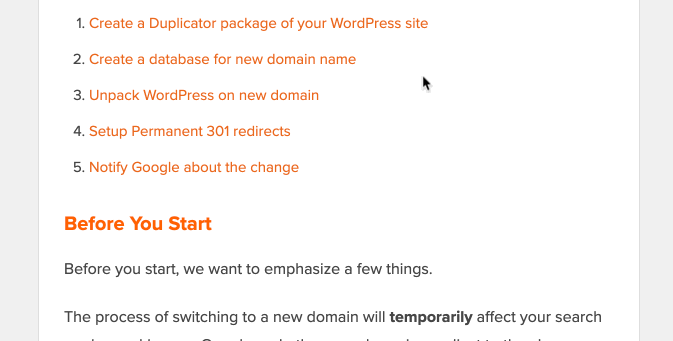
La razón por la que nos gusta la característica de tabla de contenidos de AIOSEO es que le permite personalizar los encabezados y ocultar selectivamente los encabezados según sea necesario.
Esta es una característica crítica que la mayoría de los otros plugins de tabla de contenidos simplemente no tienen.
Método 2: Añadir una tabla de contenidos manualmente en WordPress
También puede crear una tabla de contenidos manualmente utilizando enlaces de anclaje sin necesidad de un plugin. Sin embargo, esto le llevará más tiempo y esfuerzo.
Puede obtener más información acerca de los enlaces de anclaje en nuestra guía sobre cómo añadir enlaces de anclaje en WordPress.
Introducir el índice de contenidos
En primer lugar, debe añadir un bloque “Lista” en el que podrá añadir los encabezados del índice. Puede escribir los encabezados en la lista o copiarlos y pegarlos uno a uno desde el contenido de su artículo.

Cómo añadir texto de anclaje a los bloques encabezados
A continuación, tendrá que añadir un atributo de anclaje a cada encabezado al que desee hacer referencia en la tabla de contenidos. Esto permitirá a WordPress saber dónde saltar cuando un visitante haga clic en el encabezado de la tabla de contenidos.
Primero debe hacer clic en el encabezado, como H2 o H3. A continuación, debe hacer clic en la flecha “Avanzado” del panel de ajustes del bloque para mostrar los ajustes avanzados.
A continuación, introduzca una palabra o frase única sin espacios en el campo “Anclaje HTML”. Si lo desea, puede utilizar guiones para separar cada palabra.
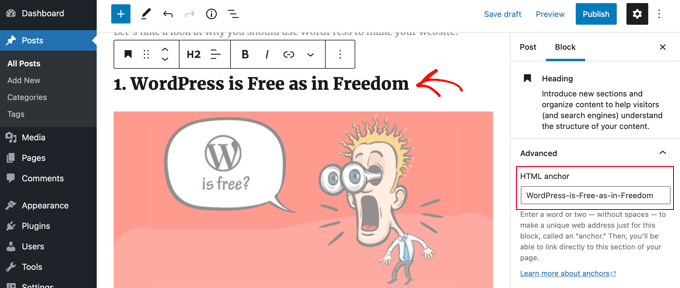
A continuación, repita esta operación para todos los demás encabezados que se incluirán en el índice.
Sugerencia: Si pega el encabezado en este campo, se añadirán guiones automáticamente. Esta es una forma sencilla de crear un ID único que también represente vaciamente el encabezado.
Añadir enlaces de anclaje al índice de contenidos
El último paso consiste en enlazar los encabezados del índice con los anclajes HTML que ha creado.
Marque la primera entrada del bloque de su lista y haga clic en el icono “Enlazar” de la barra de herramientas.

A continuación, debe escribir un hashtag (#) y luego escribir o pegar el texto de anclaje de ese encabezado.
El # indica a WordPress que salte a esa sección de la entrada actual. No añade el nombre de dominio u otros parámetros URL.

Una vez hecho esto, pulse “Intro” o haga clic en el icono “Enviar” para enlazar.
El enlace de anclaje se añadirá a su tabla de contenidos. Cuando sus visitantes hagan clic en este enlazar, serán llevados inmediatamente a ese encabezado en los contenidos de la entrada o página.

Puede repetir estos pasos para añadir enlaces de anclaje a los demás encabezados del índice.
Esperamos que este tutorial te haya ayudado a aprender cómo crear una tabla de contenidos en entradas y páginas de WordPress. Puede que también quieras ver nuestra guía sobre cómo aumentar el tráfico de tu blog o nuestra selección experta de los plugins de WordPress imprescindibles para hacer crecer tu sitio.
If you liked this article, then please subscribe to our YouTube Channel for WordPress video tutorials. You can also find us on Twitter and Facebook.





Syed Balkhi says
Hey WPBeginner readers,
Did you know you can win exciting prizes by commenting on WPBeginner?
Every month, our top blog commenters will win HUGE rewards, including premium WordPress plugin licenses and cash prizes.
You can get more details about the contest from here.
Start sharing your thoughts below to stand a chance to win!
Sam Smith says
I am in word press post editor and I do not see the blue plus button or the advanced block. How do I see those features?
WPBeginner Support says
If you re using the block editor then you may want to try disabling distraction free editing in the top-right and that should allow you to see the plus again.
Administrador
Ahmed Omar says
I am already using the first method, and it help my site to appear first in some search results and of course bringing more visitors
Thank you
WPBeginner Support says
You’re welcome!
Administrador
Thank you so much says
Can you please tell how to change the font color in TOC?
WPBeginner Support says
For that, you would need to use CSS to change the color of the text. You can see how to change the text color in our article below!
https://www.wpbeginner.com/wp-tutorials/how-to-change-the-text-color-in-wordpress-easy-methods/
Administrador
ario says
I tried to create table of content manually like the way you taught us and it worked well, until I added page break and separated the points into different parts or pages. Is there a solution for this?
WPBeginner Support says
If you separate the page then you would need to include the entire URL before the # as well as the anchor to link correctly.
Administrador
Mark says
Back in the day, when websites were new, we used to call this a Site Map. But yeah, it was kind of expected for the search engines to find a site map on your website.
Thanks for the reminder and the info.
WPBeginner Support says
Sitemaps are slightly different, we have our guide below for sitemaps specifically. The Table of contents is to allow your visitors to jump to a specific section of a post
https://www.wpbeginner.com/beginners-guide/what-is-a-wordpress-sitemap-how-to-create-a-sitemap-in-wordpress/
Administrador
samarth says
Which one is better for SEO? Adding TOC manually by HTML or using a Plugin?
WPBeginner Support says
If the information added is the same, then there is no difference. The plugin is there to help make the process easier and help ensure any markup is properly added.
Administrador
Tay says
How can I manually place the TOC on specific pages? It seems I can only disable auto-insertion but I can’t then decide where I want to put the table on the page. Is this possible?
WPBeginner Support says
The table of contents would need to be enabled for pages and then there should be an option when editing the specific page you want to add it to.
Administrador
Muhammad Arslan Sharif says
What a tutorial and very helpful for me and other who want to add new features in their websites and in blogs. In very short words you explain exceptionally.
WPBeginner Support says
Glad you found our guide helpful
Administrador
Rianne says
Brilliant! What I thought would take me hours took me 20 minutes instead
WPBeginner Support says
Glad our guide was helpful
Administrador
Claudia says
Thank you for all your helpful articles!
WPBeginner Support says
You’re welcome
Administrador
Kim Balchios says
My developer created a Table of Contents on a really long blog I wrote. I edited one of the entries and the link fell off.
When I try to create a new entry it says “Paste URL or type to search.” If I add the URL, it will take the reader to the top of the blog not the exact place inside the blog.
WPBeginner Support says
You would want to create an anchor link following our guide below:
https://www.wpbeginner.com/beginners-guide/how-to-easily-add-anchor-links-in-wordpress-step-by-step/
Administrador
David Ellin says
this video shows me how to create a table of contents within a post. I want to create a table of contents for my entire blog so that the title of each article appears in the TOC. How do I do that?
WPBeginner Support says
You would want to take a look at our article below for how to create a blog page as a ToC would get far too long for what you’re wanting to do.
https://www.wpbeginner.com/wp-tutorials/how-to-create-a-separate-page-for-blog-posts-in-wordpress/
Administrador
jean says
Hi thank you for this informative post!
Only a small question, what is “override the global settings for this specific post / page.”
I chose to insert the table of content manually, and when i check only for h2 & h3, the table of content just doesn’t show up at all.
Thank you!
WPBeginner Support says
That would mean you are telling it to ignore your default settings for the plugin for that specific post/page. If you have no H2 or H3s on the page then there wouldn’t be anything for the plugin to add to the table.
Administrador
Ahmad Zeeshan says
In setting there is no “Table of Content”. Where to find it?
WPBeginner Support says
You would want to ensure you activated the plugin after installing it.
Administrador
Dheeraj soni says
Thanks for sharing an informative article, your content always helps me to go next level.
WPBeginner Support says
You’re welcome, glad you found our content helpful
Administrador
Asthen says
Why wpbeginner don’t recommend using TOC unless it’s really long ?
How long is too long ?
WPBeginner Support says
If the page is too short to scroll then there wouldn’t be a reason to have a table of contents. It is a personal preference for the length of a post.
Administrador
SAHIL DHIMAAN says
Hi, very helpful article
But….
Table of content isn’t showing in Mobile, what to do…
i use AMP plugin also…
WPBeginner Support says
Your AMP plugin would be removing the plugin’s additions. If you reach out to the table of contents plugin’s support they can let you know if they have AMP support.
Administrador
Bee Lian Low says
Thank you, I have waited so long before I decided to install this Table Of ontent!
WPBeginner Support says
You’re welcome
Administrador
Cecilia says
Thanks. Easy to use.
WPBeginner Support says
You’re welcome
Administrador
Lucimar says
Good afternoon!
Congratulations on the article, it helped me a lot
However, it just didn’t work on amp pages.
Note: I use the “Accelerated Mobile Pages” plugin.
How can I solve?
Thank you!
WPBeginner Support says
You would want to reach out to the plugin’s support for if there is a recommendation for AMP.
Administrador
Džangir Kolar says
Hi!
How those this plugin affect the speed of the page itself?
WPBeginner Support says
It shouldn’t affect your page’s speed.
Administrador
Luke Richardson says
Using easy table of contents, is there an option to create hyperlinks to jump to that particular section when you click on one of the headings in the table.
Not sure if I’m missing something with the plugin, but when I click on the headings it doesn’t jump to that section at all.
thanks
WPBeginner Support says
The plugin should be allowing that, you may want to ensure there is enough room between your content and you don’t have any browser addons that would prevent scrolling to a certain section of your page.
Administrador
Tosh Lubek says
I’ve checked “Initially hide the table of contents” but the TOC shows every time I open a post with a TOC. Is there something else I need to do?
WPBeginner Support says
You would want to reach out to the plugin’s support to ensure this is not a conflict between the plugin and your theme
Administrador
Oulimata says
As usual, amazingly detailed and helpful. You guys have definitely become my go-to resource for anything blogging related.
WPBeginner Support says
Thank you, glad we can continue to be helpful
Administrador
Raaz shrestha says
The plugin is really great. Thanks for sharing wpbeginner team.
WPBeginner Support says
Glad you liked our recommendation
Administrador
Akamps says
Hey is there a way i can put this table of contents in my sidebar
WPBeginner Support says
The plugin does have a widget you can use
Administrador
Nic says
Is there anyway to centre the table?
WPBeginner Support says
You would need to enable custom CSS and depending on your theme would determine the CSS needed
Administrador
KM says
How use the plugin “manually” just one lost at a time? Instructions not clear
WPBeginner Support says
You would enable support for the post type you want to have the table of contents in and when you edit one of the types where it is activated, it will have the option at the bottom of the editor to add the table of contents
Administrador
Kelvin says
NO it’s POSTS again – not pages!
How do I get a table into a page?
WPBeginner Support says
In the plugin’s settings you would enable support for pages and you should be able to follow the same procedure for pages that you do for posts.
Administrador
Rishi says
nice
WPBeginner Support says
Glad you like our article
Administrador
Abhishek says
Hi, is this possible to show/hide individual headings, just by clicking on it, like on Wikipedia?
I have too many subheadings under each h3 so I want it to be easier to navigate.
WPBeginner Support says
Hi Abhishek,
Please see our article on how to show hide text in WordPress using toggle effect.
Administrador
Alex says
Thanks for article!
Prince Gabriel Okocha says
I have installed this plugin on my blog following the guideline in this post. But it’s not showing up on my posts. Is there anything I’m doing wrong? I really need this to ASAP
WPBeginner Support says
Hello,
Please review plugin settings, you need to enable support for the posts and pages. After that edit the post and page and below the post editor you will find TOC settings. From here, you need to check the box ‘Insert table of contents’ to add it in that particular post.
Administrador
Srinu says
Thanks for the article it’s working for me, But I am getting with bullets and numbers, in TOC_Box how to change it. I already numbered with h2 tags.
so its repeated the numbers twice.
Mae says
Thank you so much! I used this for my Exclusives Library and I love it! Now my subscribers won’t have a difficult time looking for their printables.
XOXO,
Mae
Jan Peter Aursnes says
A fine plugin, but is there any way I can exclude pages? Writing in headings and using * and ⎮ does not work, for me anyway. I am not a tech guy so it could be I just need a bit of explanation.
Thanks in advance.
Raushan says
This is best plugin but when i created table of content from this plugin then showing multiple H1 tag which is not good at seo point of view.
How to solve this ?
Thanks
Sunil Suresh says
Thanks. Your article came at the right time for me! I was just now looking for something like this for a client of mine.